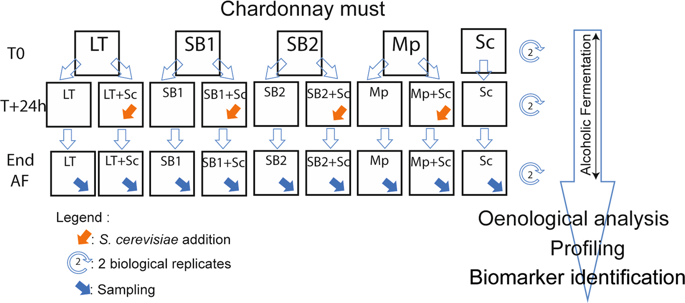Scientific Reports ( IF 3.8 ) Pub Date : 2020-04-08 , DOI: 10.1038/s41598-020-63182-6 C Roullier-Gall 1 , V David 1 , D Hemmler 2, 3 , P Schmitt-Kopplin 2, 3 , H Alexandre 1

|
As a complex microbial ecosystem, wine is a particularly interesting model for studying interactions between microorganisms as fermentation can be done by microbial consortia, a unique strain or mixed culture. The effect of a specific yeast strain on its environments is unique and characterized by its metabolites and their concentration. With its great resolution and excellent mass accuracy, ultrahigh resolution mass spectrometry (uHRMS) is the perfect tool to analyze the yeast metabolome at the end of alcoholic fermentation. This work reports the change in wine chemical composition from pure and mixed culture fermentation with Lachancea thermotolerans, Starmerella bacillaris, Metschnikowia pulcherrima and S. cerevisiae. We could clearly differentiate wines according to the yeast strain used in single cultures and markers, which reflect important differences between the yeast species, were extracted and annotated. Moreover, uHRMS revealed underlining intra species metabolomics differences, showing differences at the strain level between the two Starmerella bacillaris. Non volatile metabolomics analysis of single and sequential fermentations confirmed that mixed fermentations lead to a different composition. Distinct metabolites appeared in wines from sequential fermentation compared to single fermentation. This suggests that interactions between yeasts are not neutral.
中文翻译:

通过代谢曲线分析酵母相互作用。
作为复杂的微生物生态系统,葡萄酒是研究微生物之间相互作用的特别有趣的模型,因为发酵可以通过微生物联盟,独特的菌株或混合培养来完成。特定酵母菌株对其环境的影响是独特的,并以其代谢产物及其浓度为特征。超高分辨率质谱(uHRMS)具有高分辨率和出色的质量准确度,是在酒精发酵结束时分析酵母代谢组的理想工具。这项工作报告了纯培养和混合培养的发酵,用Lachancea thermotolerans,芽孢杆菌,Metschnikowia pulcherrima和S. cerevisiae进行的葡萄酒化学成分变化。。我们可以根据用于单一培养物的酵母菌株清楚地区分葡萄酒,并提取和标注反映酵母物种之间重要差异的标记。而且,uHRMS揭示了物种内部代谢组学上的差异,显示了两个Starmerella bacillaris之间菌株水平的差异。单次发酵和连续发酵的非易失性代谢组学分析证实,混合发酵导致不同的组成。与单次发酵相比,顺序发酵的葡萄酒中出现了不同的代谢产物。这表明酵母之间的相互作用不是中性的。











































 京公网安备 11010802027423号
京公网安备 11010802027423号